实验八 进程间通信
实验八 进程间通信
|
项目 |
内容 |
|
这个作业属于哪个课程 |
|
|
这个作业的要求在哪里 |
|
|
学号-姓名 |
17043227-张健 |
|
作业学习目标 |
1. 了解进程间通信的常用方式;<br />2. 掌握管道、消息队列、信号量、共享内存实现进程间通信的方法。 |
1. 管道通信
匿名管道
当进程使用 pipe 函数,就可以打开位于内核中的这个特殊“文件”。同时 pipe 函数会返回两个描述
符,一个用于读,一个用于写。如果你使用 fstat 函数来测试该描述符,可以发现此文件类型为
FIFO 。而无名管道的无名,指的就是这个虚幻的“文件”,它没有名字。
man 2 pipe
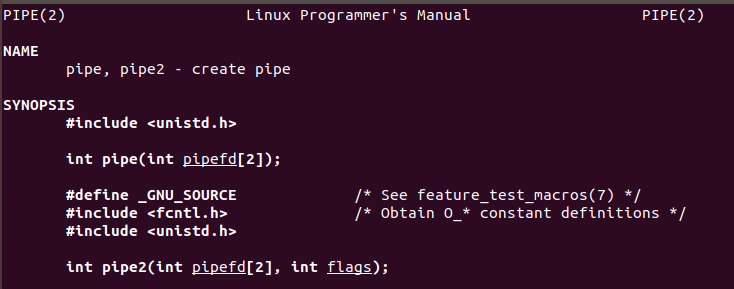
pipe 函数打开的文件描述符是通过参数(数组)传递出来的,而返回值表示打开成功(0)或失败(-1)。
它的参数是一个大小为 2 的数组。此数组的第 0 个元素用来接收以读的方式打开的描述符,而第 1 个元素用来接收以写的方式打开的描述符。也就是说, pipefd[0] 是用于读的,而 pipefd[1] 是用于写的。
打开了文件描述符后,就可以使用 read(pipefd[0]) 和 write(pipefd[1]) 来读写数据了。

注意事项:
这两个分别用于读写的描述符必须同时打开才行,否则会出问题。
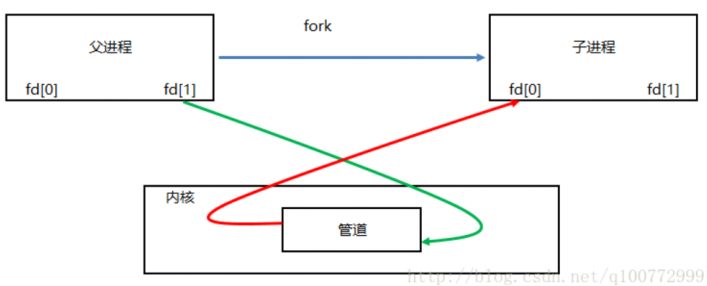
如果关闭读 ( close(pipefd[0]) ) 端保留写端,继续向写端 ( pipefd[1] ) 端写数据( write 函数)的进程会收到 SIGPIPE 信号。
如果关闭写 ( close(pipefd[1]) ) 端保留读端,继续向读端 ( pipefd[0] ) 端读数据( read 函数), read 函数会返回 0.
例题:父进程 fork 出一个子进程,通过无名管道向子进程发送字符,子进程收到数据后将字符串中的
小写字符转换成大写并输出。

|
1
2
3
4
5
6
7
8
9
10
11
12
13
14
15
16
17
18
19
20
21
22
23
24
25
26
27
28
29
30
31
32
33
34
35
36
37
38
39
40
41
42
43
44
45
46
|
#include <unistd.h> #include <stdio.h>#include <stdlib.h>#include <ctype.h> void child(int *fd) {close(fd[1]); // 子进程关闭写端char buf[64];int n = 0,i;while(1) {n = read(fd[0], buf, 64);//如果没有数据可读,read会阻塞;如果父进程退出, read 返回 0.for (i = 0; i < n; ++i)putchar(toupper(buf[i]));if (*buf == 'q') {close(fd[0]);exit(0);}if (n == 0) {puts("no data to read!");sleep(1);}}exit(0); }int main() {int fd[2];//作为传出参数int n = 0;char buf[64] = { 0 };if (pipe(fd) < 0) {perror("pipe");return -1;}pid_t pid = fork();if (pid == 0) {child(fd);}close(fd[0]);// 父进程关闭读端while (1) {n = read(STDIN_FILENO, buf, 64);write(fd[1], buf, n);if (*buf == 'q') {close(fd[1]);exit(0);}}return 0; } |
命名管道
1) 通过命令 mkfifo 创建管道
man mkfifo
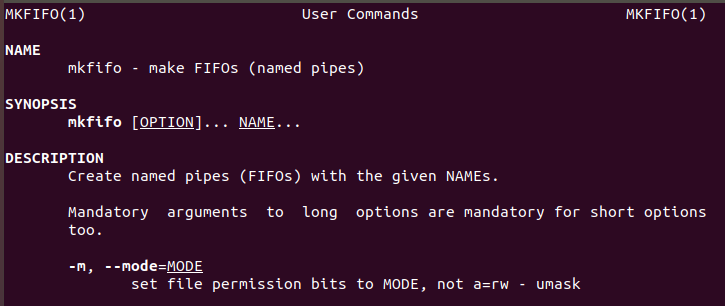
2) 通过函数 mkfifo(3) 创建管道
man 3 mkfifo

FIFO 文件的特性
a) 查看文件属性
当使用 mkfifo 创建 hello 文件后,查看文件信息如下:

某些版本的系统在 hello 文件后面还会跟着个 | 符号,像这样 hello|
b) 使用 cat 命令打印 hello 文件内容

接下来你的 cat 命令被阻塞住。
开启另一个终端,执行:

然后你会看到被阻塞的 cat 又继续执行完毕,在屏幕打印 “hello world” 。如果你反过来执行上面两个命令,会发现先执行的那个总是被阻塞。

c) fifo 文件特性
根据前面两个实验,可以总结:
文件属性前面标注的文件类型是 p ,代表管道
文件大小是 0
fifo 文件需要有读写两端,否则在打开 fifo 文件时会阻塞
当然了,如果在 open 的时候,使用了非阻塞方式,肯定是不会阻塞的。特别地,如果以非阻塞写的方式 open ,同时没有进程为该文件以读的方式打开,会导致 open 返回错误(-1),同时 errno 设置成ENXIO .
例题:编写两个程序,分别是发送端 pipe_send 和接收端面 pipe_recv 。程序 pipe_send 从标准
输入接收字符,并发送到程序 pipe_recv ,同时 pipe_recv 将接收到的字符打印到屏幕。
|
1
2
3
4
5
6
7
8
9
10
11
12
13
14
15
16
17
18
19
20
21
22
23
24
|
// pipe_send.c#include <unistd.h>#include <sys/types.h> #include <sys/stat.h>#include <fcntl.h>#include <stdio.h>int main() {char buf[64];int n = 0;int fd = open("hello", O_WRONLY);if (fd < 0) {perror("open fifo");return -1;}puts("has opend fifo");while((n = read(STDIN_FILENO, buf, 64)) > 0) {write(fd, buf, n);if (buf[0] == 'q')break;}close(fd);return 0;} |
|
1
2
3
4
5
6
7
8
9
10
11
12
13
14
15
16
17
18
19
20
21
22
23
24
25
26
27
28
29
30
|
// pipe_recv.c #include <unistd.h> #include <sys/types.h>#include <sys/stat.h>#include <fcntl.h>#include <stdio.h> int main() {char buf[64];int n = 0;int fd = open("hello", O_RDONLY);if (fd < 0) {perror("open fifo");return -1;}puts("has opened fifo");while((n = read(fd, buf, 64)) > 0) {write(STDOUT_FILENO, buf, n);}if (n == 0) {puts("remote closed");}else {perror("read fifo");return -1;}close(fd);return 0; } |

分别开启两个终端,分别运行 pipe_send 和 pipe_recv :


现在两个终端都处于阻塞状态,我们在运行 pipe_send 的终端输入数据,然后我们就可以在运行
pipe_recv 的终端看到相应的输出:


可以用组合按键结束上述两个进程。
2. IPC 内核对象
每个 IPC 内核对象都是位于内核空间中的一个结构体。具体的对于共享内存、消息队列和信号量,他们在内核空间中都有对应的结构体来描述。当你使用 get 后缀创建内核对象时,内核中就会为它开辟一块内存保存它。只要你不显式删除该内核对象,它就永远位于内核空间中,除非你关机重启。
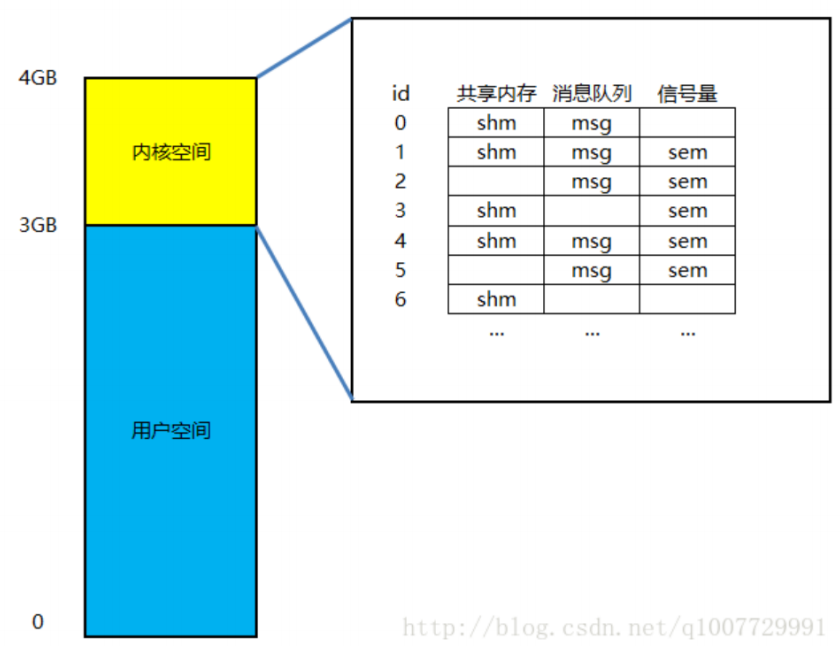
进程空间的高 1G 空间( 3GB-4GB )是内核空间,该空间中保存了所有的 IPC 内核对象。上图给出不同的 IPC 内核对象在内存中的布局(以数组的方式),实际操作系统的实现并不一定是数组,也可能是链表或者其它数据结构等等。每个内核对象都有自己的 id 号(数组的索引)。此 id 号可以被用户空间使用。所以只要用户空间知道了内核对象的 id 号,就可以操控内核对象了。
为了能够得到内核对象的 id 号,用户程序需要提供键值—— key ,它的类型是 key_t ( int 整型)。系统调用函数( shmget , msgget 和 semget )根据 key ,就可以查找到你需要的内核 id号。在内核创建完成后,就已经有一个唯一的 key 值和它绑定起来了,也就是说 key 和内核对象是一一对应的关系。( key = 0 为特殊的键,它不能用来查找内核对象)
创建 IPC 内核对象
man 2 shmget
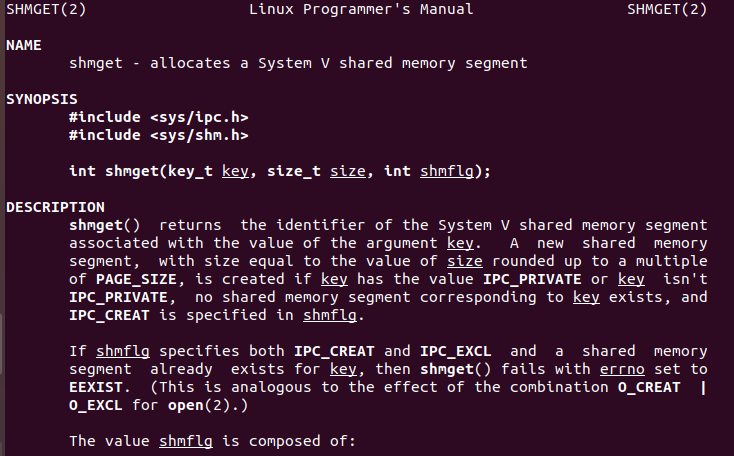
man 2 msgget

man 2 semget
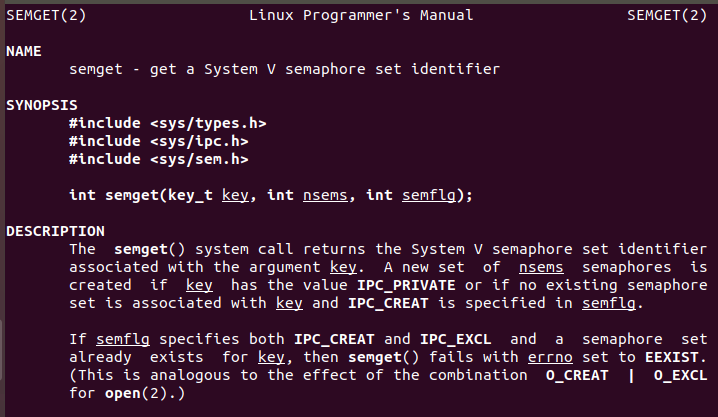
在创建 IPC 内核对象时,用户程序一定需要提供 key 值才行。实际上,创建 IPC 内核对象的函数和获取内核对象 id 的函数是一样的,都是使用 get 后缀函数。比如在键值 0x8888 上创建 ipc 内核对象,并获取其 id ,应该像下面这样:
|
1
2
3
4
|
// 在 0x8888 这个键上创建内核对象,权限为 0644,如果已经存在就返回错误。int id = shmget(0x8888, 4096, IPC_CREAT | IPC_EXCL | 0644);int id = msgget(0x8888, IPC_CREAT | IPC_EXCL | 0644);int id = semget(0x8888, 1, IPC_CREAT | IPC_EXCL | 0644); // 第二个参数表示创建 几个信号量 |
例题:程序 ipccreate 用于在指定的键值上创建 ipc 内核对象。使用格式为 ./ipccreate ,比如./ipccreate 0 0x8888 表示在键值 0x8888 上创建共享内存。
|
1
2
3
4
5
6
7
8
9
10
11
12
13
14
15
16
17
18
19
20
21
22
23
24
25
26
27
28
29
30
31
32
33
34
35
36
37
38
39
40
41
|
// ipccreate.c #include <unistd.h> #include <sys/ipc.h> #include <sys/shm.h>#include <sys/msg.h> #include <sys/sem.h>#include <stdio.h>#include <stdlib.h> #include <string.h>int main(int argc, char* argv[]) {if (argc < 3) {printf("%s <ipc type> <key>\n", argv[0]);return -1;}key_t key = strtoll(argv[2], NULL, 16);//keychar type = argv[1][0];//char buf[64];int id;if (type == '0') {//创建共享内存id = shmget(key, getpagesize(), IPC_CREAT | IPC_EXCL | 0644);strcpy(buf, "share memory");}else if (type == '1') {//创建消息队列id = msgget(key, IPC_CREAT | IPC_EXCL | 0644);strcpy(buf, "message queue");}else if (type == '2') {//创建信号量id = semget(key, 5, IPC_CREAT | IPC_EXCL | 0644);strcpy(buf, "semaphore");}else {printf("type must be 0, 1, or 2\n");return -1;}if (id < 0) {perror("get error");return -1;}printf("create %s at 0x%x, id = %d\n", buf, key, id);return 0;} |
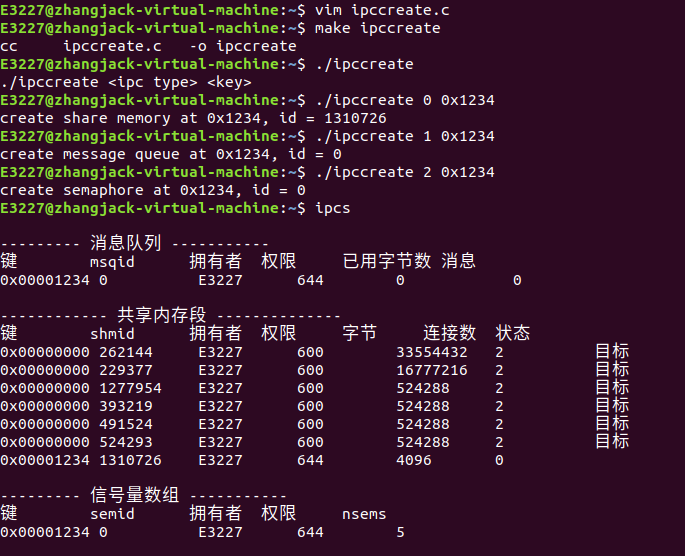
获取 ipc 内核对象
程序 ipcget 用于在指定的键值上获取 ipc 内核对象的 id 号。使用格式为 ./ipcget ,比如./ipcget 0 0x8888 表示获取键值 0x8888 上的共享内存 id 号。
|
1
2
3
4
5
6
7
8
9
10
11
12
13
14
15
16
17
18
19
20
21
22
23
24
25
26
27
28
29
30
31
32
33
34
35
36
37
38
39
40
41
|
// ipcget.c#include <unistd.h> #include <sys/ipc.h>#include <sys/shm.h>#include <sys/msg.h> #include <sys/sem.h>#include <stdio.h> #include <stdlib.h> #include <string.h> int main(int argc, char* argv[]) {if (argc < 3) {printf("%s <ipc type> <key>\n", argv[0]);return -1;}key_t key = strtoll(argv[2], NULL, 16);char type = argv[1][0];char buf[64];int id;if (type == '0') {id = shmget(key, 0, 0);strcpy(buf, "share memory");}else if (type == '1') {id = msgget(key, 0);strcpy(buf, "message queue");}else if (type == '2') {id = semget(key, 0, 0);strcpy(buf, "semaphore");}else {printf("type must be 0, 1, or 2\n");return -1;}if (id < 0) {perror("get error");return -1;}printf("get %s at 0x%x, id = %d\n", buf, key, id);return 0;} |

3. 共享内存
前面已经知道如何创建内核对象,接下来分别了解三种内核对象的操作:
man 2 shmop

man 2 shmctl
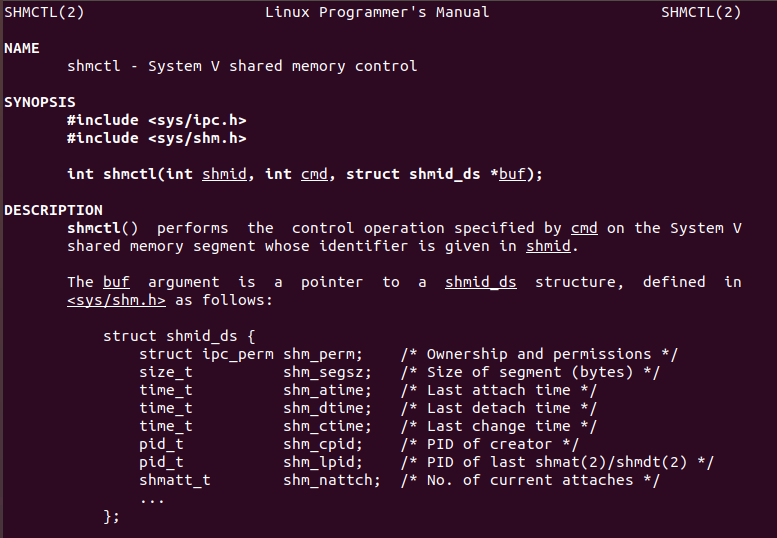
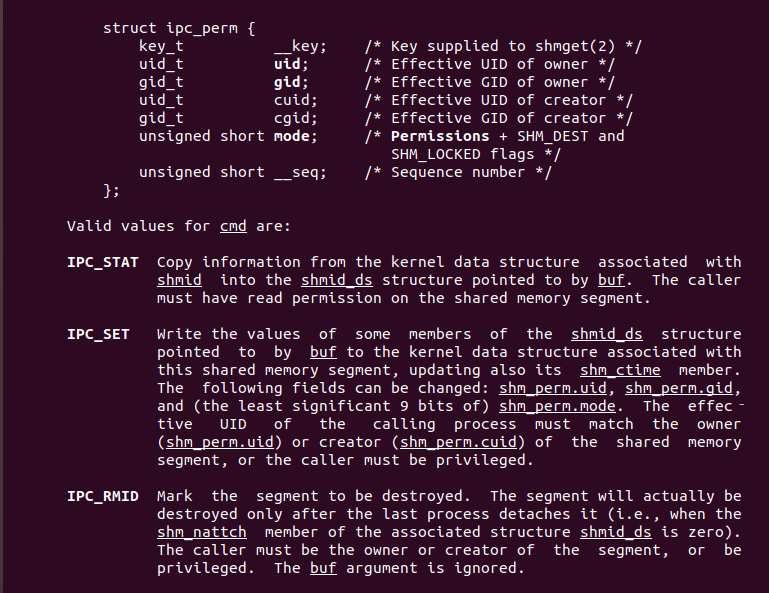
例题:编写一个程序 shmctl 可以用来创建、删除内核对象,也可以挂接、卸载共享内存,还可以打印、设置内核对象信息。具体使用方法具体见下面的说明:
./shmctl -c : 创建内核对象。
./shmctl -d : 删除内核对象。
./shmctl -v : 显示内核对象信息。
./shmctl -s : 设置内核对象(将权限设置为 0600 )。
./shmctl -a : 挂接和卸载共享内存(挂接 5 秒后,再执行 shmdt ,然后退出)。
|
1
2
3
4
5
6
7
8
9
10
11
12
13
14
15
16
17
18
19
20
21
22
23
24
25
26
27
28
29
30
31
32
33
34
35
36
37
38
39
40
41
42
43
44
45
46
47
48
49
50
51
52
53
54
55
56
57
58
59
60
61
62
63
64
65
66
67
68
69
70
71
72
73
74
75
76
77
78
79
80
81
82
83
84
85
86
87
88
89
90
91
92
93
|
// shmctl.c#include <unistd.h>#include <sys/ipc.h>#include <sys/shm.h>#include <stdio.h>#include <time.h>#include <stdlib.h>#include <string.h> #define ASSERT(res) if((res)<0){perror(__FUNCTION__);exit(-1);}// 打印 ipc_permvoid printPerm(struct ipc_perm *perm) {printf("euid of owner = %d\n", perm->uid);printf("egid of owner = %d\n", perm->gid);printf("euid of creator = %d\n", perm->cuid);printf("egid of creator = %d\n", perm->cgid);printf("mode = 0%o\n", perm->mode);}// 打印 ipc 内核对象信息void printShmid(struct shmid_ds *shmid) {printPerm(&shmid->shm_perm);printf("segment size = %d\n", shmid->shm_segsz);printf("last attach time = %s", ctime(&shmid->shm_atime));printf("last detach time = %s", ctime(&shmid->shm_dtime));printf("last change time = %s", ctime(&shmid->shm_ctime));printf("pid of creator = %d\n", shmid->shm_cpid);printf("pid of last shmat/shmdt = %d\n", shmid->shm_lpid);printf("No. of current attaches = %ld\n", shmid->shm_nattch);}// 创建 ipc 内核对象void create() {int id = shmget(0x8888, 123, IPC_CREAT | IPC_EXCL | 0664);printf("create %d\n", id);ASSERT(id);}// IPC_STAT 命令使用,用来获取 ipc 内核对象信息void show() {int id = shmget(0x8888, 0, 0);ASSERT(id);struct shmid_ds shmid;ASSERT(shmctl(id, IPC_STAT, &shmid));printShmid(&shmid);}// IPC_SET 命令使用,用来设置 ipc 内核对象信息void set() {int id = shmget(0x8888, 123, IPC_CREAT | 0664);ASSERT(id);struct shmid_ds shmid;ASSERT(shmctl(id, IPC_STAT, &shmid));shmid.shm_perm.mode = 0600;ASSERT(shmctl(id, IPC_SET, &shmid));printf("set %d\n", id);}// IPC_RMID 命令使用,用来删除 ipc 内核对象void rm() {int id = shmget(0x8888, 123, IPC_CREAT | 0664);ASSERT(id);ASSERT(shmctl(id, IPC_RMID, NULL));printf("remove %d\n", id);}// 挂接和卸载void at_dt() {int id = shmget(0x8888, 123, IPC_CREAT | 0664);ASSERT(id);char *buf = shmat(id, NULL, 0);if (buf == (char*)-1) ASSERT(-1);printf("shmat %p\n", buf);sleep(5); // 等待 5 秒后,执行 shmdtASSERT(shmdt(buf));printf("shmdt %p\n", buf);}int main(int argc, char *argv[]) {if (argc < 2) {printf("usage: %s <option -c -v -s -d -a>\n", argv[0]);return -1;}printf("I'm %d\n", getpid());if (!strcmp(argv[1], "-c")) {create();}else if (!strcmp(argv[1], "-v")) {show();}else if (!strcmp(argv[1], "-s")) {set();}else if (!strcmp(argv[1], "-d")) {rm();}else if (!strcmp(argv[1], "-a")) {at_dt();}return 0;} |

先在另一个终端执行 ./shmctl -a ,然后在当前终端执行 ./shmctl -v


4. 消息队列
消息队列本质上是位于内核空间的链表,链表的每个节点都是一条消息。每一条消息都有自己的消类型,消息类型用整数来表示,而且必须大于 0.每种类型的消息都被对应的链表所维护,下图 展示了内核空间的一个消息队列:

其中数字 1 表示类型为 1 的消息,数字2、3、4 类似。彩色块表示消息数据,它们被挂在对应类型链表上。值得注意的是,刚刚说过没有消息类型为 0 的消息,实际上,消息类型为 0 的链表记录了所有消息加入队列的顺序,其中红色箭头表示消息加入的顺序。
消息队列相关的函数
man 2 msgop
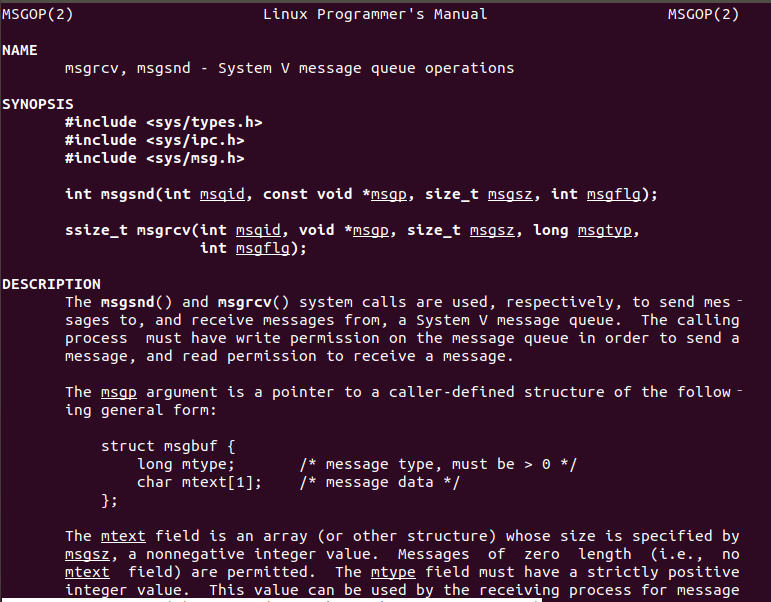
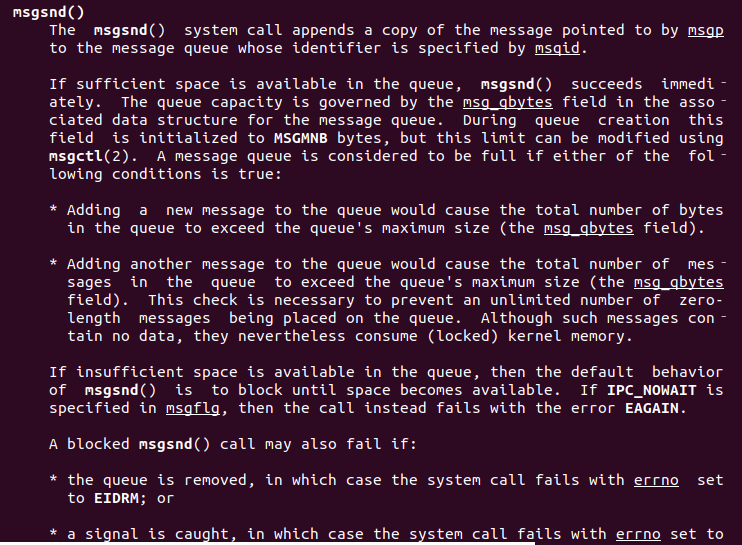
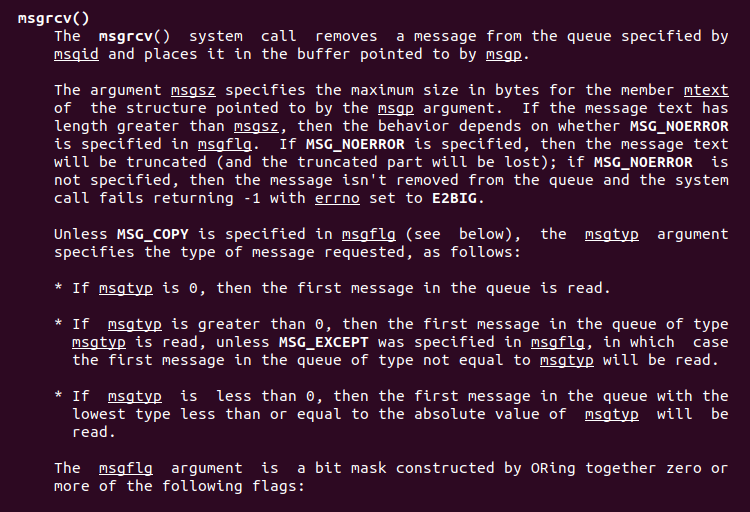
消息数据格式
无论你是发送还是接收消息,消息的格式都必须按照规范来。简单的说,它一般长成下面这个样子:
|
1
2
3
4
5
6
|
struct Msg{long type;// 消息类型。这个是必须的,而且值必须 > 0,这个值被系统使用// 消息正文,多少字节随你而定 // ...} |
例题:程序 msg_send 和 msg_recv 分别用于向消息队列发送数据和接收数据。 msg_send 程序定义了一个结构体 Msg ,消息正文部分是结构体 Person 。该程序向消息队列发送了 10 条消息。
|
1
2
3
4
5
6
7
8
9
10
11
12
13
14
15
16
17
18
19
20
21
22
23
24
25
26
27
28
29
30
31
32
33
34
35
36
37
|
// msg_send.c#include <unistd.h>#include <sys/ipc.h>#include <sys/msg.h>#include <stdio.h>#include <stdlib.h>#define ASSERT(prompt,res) if((res)<0){perror(#prompt);exit(-1);}typedef struct {char name[20];int age;}Person;typedef struct {long type;Person person;}Msg;int main(int argc, char *argv) {int id = msgget(0x8888, IPC_CREAT | 0664);ASSERT(msgget, id);Msg msg[10] = {{1, {"Luffy", 17}},{1, {"Zoro", 19}},{2, {"Nami", 18}},{2, {"Usopo", 17}},{1, {"Sanji", 19}},{3, {"Chopper", 15}},{4, {"Robin", 28}},{4, {"Franky", 34}},{5, {"Brook", 88}},{6, {"Sunny", 2}}};int i;for (i = 0; i < 10; ++i) {int res = msgsnd(id, &msg[i], sizeof(Person), 0);ASSERT(msgsnd, res);}return 0;} |
程序 msg_send 第一次运行完后,内核中的消息队列大概像下面这样:

msg_recv 程序接收一个参数,表示接收哪种类型的消息。比如 ./msg_recv 4 表示接收类型为 4 的消息,并打印在屏幕。
|
1
2
3
4
5
6
7
8
9
10
11
12
13
14
15
16
17
18
19
20
21
22
23
24
25
26
27
28
29
30
31
32
33
34
35
36
37
38
39
40
41
42
43
44
|
// msg_recv.c#include <unistd.h>#include <sys/types.h>#include <sys/ipc.h>#include <sys/msg.h>#include <stdio.h>#include <stdlib.h>#include <errno.h>#define ASSERT(prompt,res) if((res)<0){perror(#prompt);exit(-1);}typedef struct {char name[20];int age;}Person;typedef struct {long type;Person person;}Msg;void printMsg(Msg *msg) {printf("{ type = %ld, name = %s, age = %d }\n",msg->type, msg->person.name, msg->person.age);}int main(int argc, char *argv[]) {if (argc < 2) {printf("usage: %s <type>\n", argv[0]); return -1; }long type = atol(argv[1]);int id = msgget(0x8888, 0); ASSERT(msgget, id); Msg msg; int res; while(1) { res = msgrcv(id, &msg, sizeof(Person), type, IPC_NOWAIT); if (res < 0) { if (errno == ENOMSG) { printf("No message!\n"); break; } else { ASSERT(msgrcv, res); } } printMsg(&msg); } return 0;} |

先运行 ./msg_send ,再运行 ./msg_recv 。
接收所有消息:

接收类型为 4 的消息,这时要重新运行 ./msg_send :

接收类型小于等于 3 的所有消息,这时不用再运行 ./msg_send :

还有一个函数来操作消息队列内核对象的
man 2 msgctl

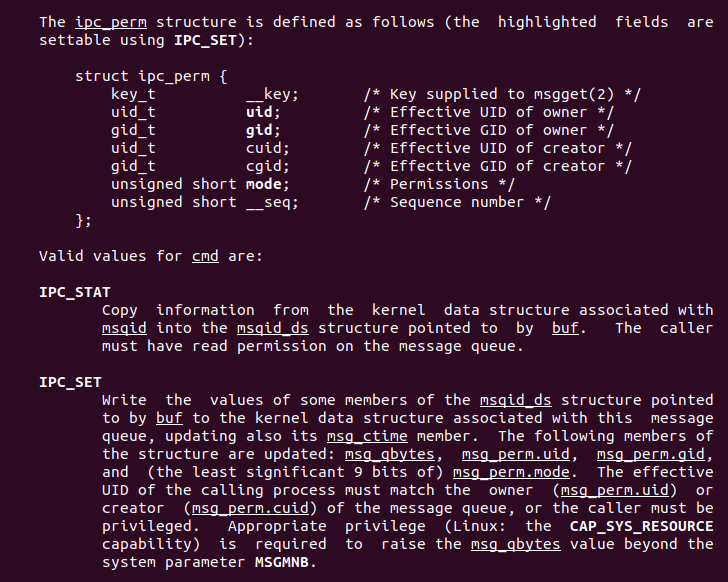
5. 信号量
设置和获取信号量值的函数 semctl :
man 2 semctl
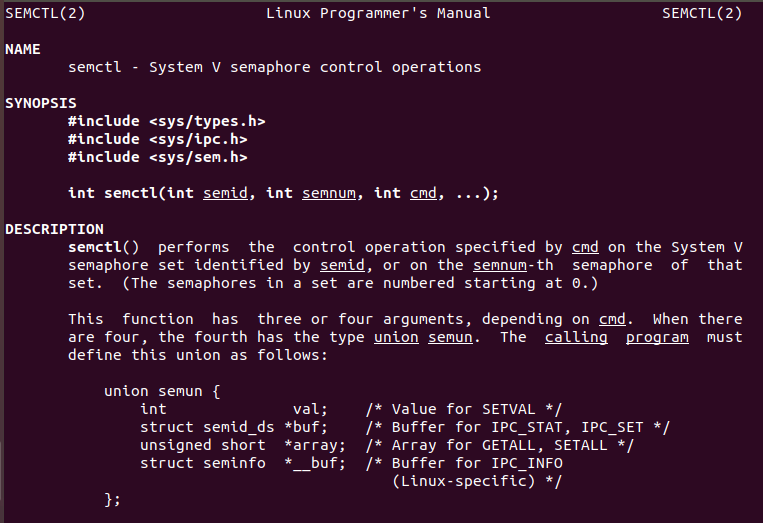
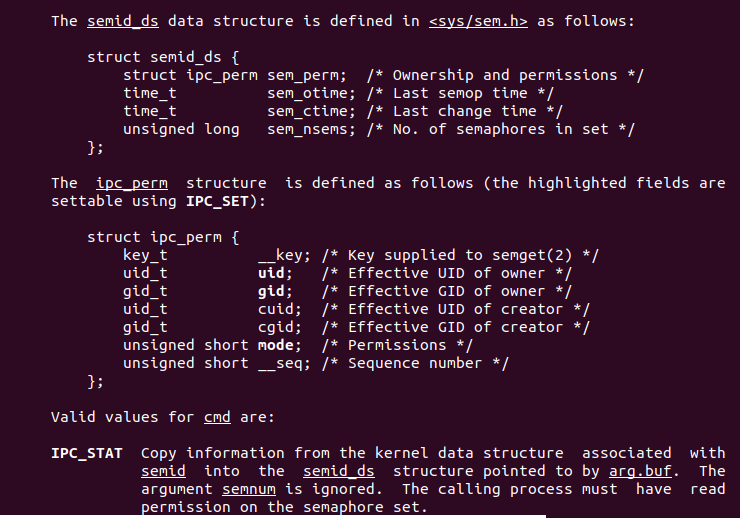
请求和释放信号量 semop
man 2 semop
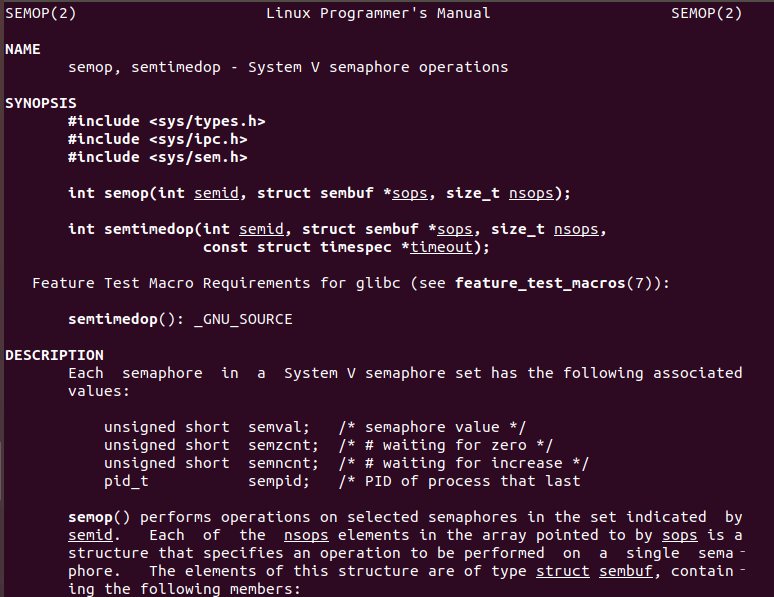
|
1
2
3
4
5
|
struct sembuf {unsigned short sem_num; /* semaphore number */short sem_op; /* semaphore operation */short sem_flg; /* operation flags */} |
例题:信号量操作 示例
|
1
2
3
4
5
6
7
8
9
10
11
12
13
14
15
16
17
18
19
20
21
22
23
24
25
26
27
28
29
30
31
32
33
34
35
36
37
38
39
40
41
42
43
44
45
46
47
48
49
50
51
52
53
54
55
56
57
58
59
60
61
62
63
64
65
66
67
68
69
70
71
|
// semop.c#include <unistd.h>#include <sys/ipc.h>#include <sys/sem.h>#include <stdio.h>#include <stdlib.h>#define R0 0#define R1 1#define R2 2void printSem(int id) {unsigned short vals[3] = { 0 };semctl(id, 3, GETALL, vals);printf("R0 = %d, R1= %d, R2 = %d\n\n", vals[0], vals[1], vals[2]);}int main() {int id = semget(0x8888, 3, IPC_CREAT | IPC_EXCL | 0664);// 打印信号量值puts("信号量初始值(默认值)");printSem(id);// 1. 设置第 2 个信号量值puts("1. 设置第 2 个信号量(R2)值为 20");semctl(id, 2, SETVAL, 20); printSem(id); // 2. 同时设置 3 个信号量的值puts("2. 同时设置 3 个信号量的值为 12, 5, 9");unsigned short vals[3] = {12, 5, 9};semctl(id, 0, SETALL, vals);printSem(id);// 3. 请求 2 个 R0 资源puts("3. 请求 2 个 R0 资源");struct sembuf op1 = {0, -2, 0};semop(id, &op1, 1);printSem(id);// 4. 请求 3 个 R1 和 5 个 R2puts("4. 请求 3 个 R1 和 5 个 R2");struct sembuf ops1[2] = {{1, -3, 0},{2, -5, 0}};semop(id, ops1, 2);printSem(id);// 5. 释放 2 个 R1puts("5. 释放 2 个 R1");struct sembuf op2 = {1, 2, 0};semop(id, &op2, 1);printSem(id);// 6. 释放 1 个 R0, 1 个 R1,3 个 R2puts("6. 释放 1 个 R0, 1 个 R1,3 个 R2");struct sembuf ops2[3] = {{0, 1, 0}, {1, 1, 0}, {2, 3, 0} }; semop(id, ops2, 3); printSem(id); // 7. 删除 ipc 内核对象 puts("7. 删除 ipc 内核对象"); semctl(id, 0, IPC_RMID); return 0;} |
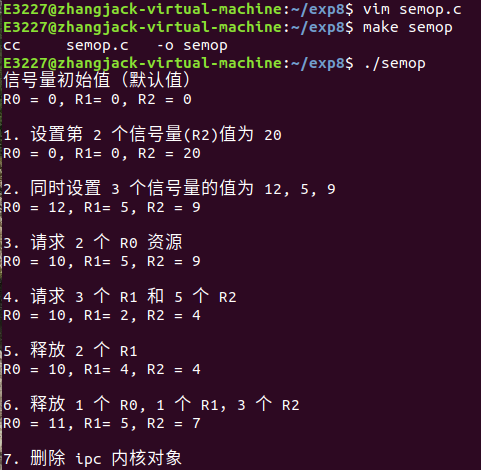
例题:使用信号量实现父子进程之间的同步,防止父子进程抢夺 CPU 。
|
1
2
3
4
5
6
7
8
9
10
11
12
13
14
15
16
17
18
19
20
21
22
23
24
25
26
27
28
29
30
31
32
33
34
35
36
37
38
39
40
41
42
43
44
45
46
47
48
49
50
51
52
53
54
55
56
57
58
59
60
61
62
63
64
65
66
67
68
69
70
71
72
|
#include<stdio.h>#include<stdlib.h>#include<sys/ipc.h>#include<sys/sem.h>static int semid;static void sem_set(){if(semctl(semid,0,SETVAL,1)==-1){perror("semctl");exit(1);}}static void sem_p(){struct sembuf op = {0,-1,0};if(semop(semid,&op,1) == -1){perror("semop");exit(1);}}static void sem_v(){struct sembuf op = {0,1,0};if(semop(semid,&op,1) == -1){perror("semop");exit(1);}}static void sem_del(){if(semctl(semid,0,IPC_RMID) == -1){perror("semctl");exit(1);}}int main(){int i;pid_t pid;char ch = 'C';semid = semget((key_t)1000,1,0664|IPC_CREAT); if(semid == -1){ perror("semget"); exit(1); } sem_set(); pid = fork(); if(pid == -1){ sem_del(); exit(1); } else if (pid == 0) ch = 'Z'; else ch = 'C'; srand((unsigned int)getpid()); for(i=0;i<8;i++) { sem_p(); printf("%c",ch); fflush(stdout); sleep(rand()%4); printf("%c",ch); fflush(stdout); sleep(1); sem_v(); } if(pid > 0) { wait(NULL); sem_del(); } printf("\n"); return 0;} |





 浙公网安备 33010602011771号
浙公网安备 33010602011771号